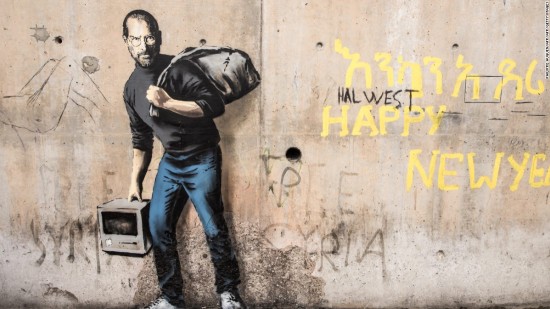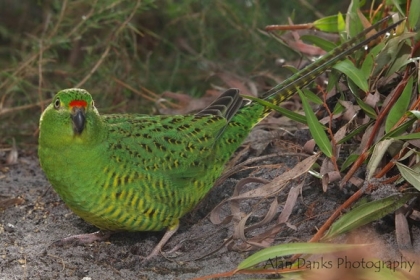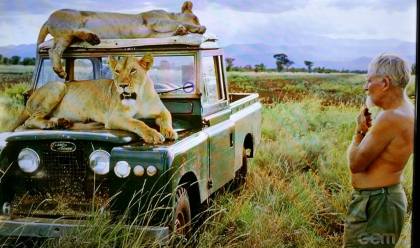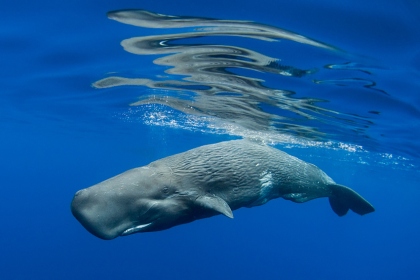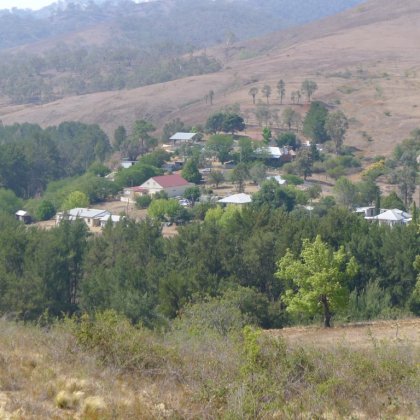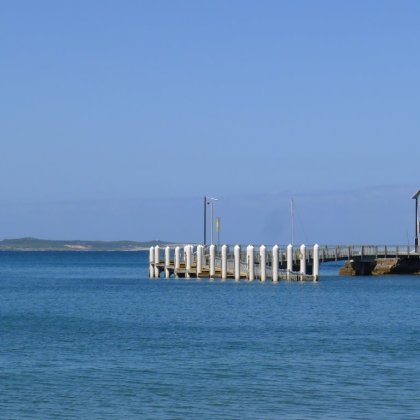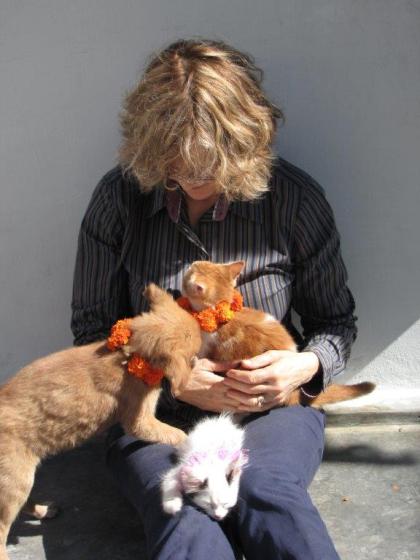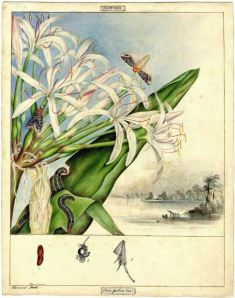CHRISTIAN: It is this time of the year again and thanks as always to Christian’s photographer Derek Cattani. Do see some of his other marvellous photographs of Christian here – I always enjoy looking at them.
Some of you may be interested in this article from the Good Weekend, Pets on E-Parade, on pet and animal-themed YouTube channels. Christian the lion was not mentioned but I think our reunion with Christian was the first really popular “animal themed” video phenomenon on YouTube – we stopped counting years ago when we topped 100 million views.
Australia’s most popular YouTube channel, Catmantoo has 133,000 subscribers and 40 million views. Many of these channels are “monetarised” and take months to prepare. In general I don’t like performing or dressed up animals. I can understand why cat videos dominate the internet and I am sent many cat videos – thanks to Mandy lately, and thankyou to Deb especially.
I recently reread a letter I wrote to George Adamson at Kora in Kenya in 1978 about our reunion with Christian in 1971: “and the footage of us returning to see Christian and him running down the hill is pretty amazing footage”. That has turned out to be quite an understatement!
ART: For anyone visiting or travelling around Australia in the next few months we have some very interesting exhibitions on at our State Galleries, and they all have extensive gallery collections.
Andy Warhol/Ai Wei Wei has just opened at the National Gallery of Victoria, Melbourne (until April 24th 2016), and is a “conversation” between the artists who did meet in New York years ago. They share a love of “social media” – Warhol was a precursor of celebrity and social media with his screen prints, polaroids, diary jottings, Interview magazine and ever present recorder – while WeiWei loves Twitter and Instagram etc.
Ai WeiWei’s passport was taken away for 4 years, and this is one of the few exhibitions where he has actually overseen the installation – the positioning of the artworks, the lighting etc. More poignantly, it is the first international exhibition of his work he has actually seen for years.
I met Eric Shiner, the Director of the Warhol Museum, in Australia for the exhibition. I asked him about both artists loving cats and he said the Children’s Education section of the exhibition is all about cats – with Ai Wei Wei drawing cat wallpaper, and the backs of chairs being cat tails! Warhol had 30 – all but one called Sam.
We were also celebrating the announcement of Tracey Moffatt being selected to represent Australia at the 2017 Venice Biennale. I can’t wait to see what she does and I intend to be there!

The Annunciation of the Virgin Deal by Grayson Perry, 2012. Jaquard woven tapestry in wool, silk, cotton, acrylic and polyester, with cotton warp.
In Sydney at the Museum of Contemporary Art is The Pretty Little Art World of Grayson Perry, the cross dressing art critic from the UK. He is most amusing, but was in trouble in Australia for saying our Aboriginal art is not “contemporary” art and should be shown in an ethnographic context. He has apologised but then said that we “mix it in” with contemporary art….
Also in Sydney, at the Art Gallery of NSW there is the rare opportunity to see wonderful paintings in The Greats: Masterpieces from the National Galleries of Scotland until 14 February 2016. Another exhibition at the AGNSW includes fascinating C19th drawings by Aboriginal artists Tommy McRae and William Barak. Murruwaygu (following in the footsteps of our ancestors), are Aboriginal artworks from south-east Australia and include Roy Kennedy and Harry J Wedge.
Wollongong Art Gallery is showing SHIMMER an exhibition “exploring expanded notions of historical and contemporary shell-working traditions in indigenous Australia”. This is especially true of Garry Sibosado and I also loved the prints of Darrell Sibosado. These brothers, from the West Kimberley coast, both reference traditional designs through contemporary art practice. I love shells and other well known artists include Esme Timbery, Tess Allas and Julie Gough.
There is more Aboriginal art in Adelaide at the Art Gallery of South Australia. TARNANTHI is an Inaugural Festival of Contemporary Aboriginal and Torres Strait Islander Art, described as a very ambitious exhibition that showcases the diversity of Aboriginal art.
A major Gilbert & George exhibition is at the privately-funded Museum of Old and New Art (MONA), in Hobart, Tasmania.
APT8, the 8th Asia Pacific Triennial is in Brisbane at the Queensland Art Gallery and GOMA until 10 April 2016. The APT was a great initiative and is always interesting. It has focused international attention on the artists of our region. I would especially like to see the contemporary tribal art from India and I have collected and exhibited Indian tribal and village artists over the years.
WORLD: A memorable and often scary year comes to the end. It will be remembered for extreme and catastrophic weather events, air crashes, mass migrations and displacement, and “terrorism”. One probably has more chance of dying from a car accident, smoking, or being shot – especially if you live in the USA. 30,000 were killed by guns there over the year – coincidentally about the number killed world-wide by terrorism.
The Middle East/Islam conflict seems as complex and unsoluble as ever and innocent people, mostly Muslim, continue to be killed.
At least a more informed debate about Islam is emerging – with the exception of Donald Trump, our ex PM Abbott, far right groups like the National Front in France, and various unattractive bogans in Australia supposedly fighting for “our values”.
I thought Waleed Aly’s article last blog was very informative – as is this more recent one. He argues “The Reformation is here. Theyr’e looking at it. The Muslim world -and indeed Islamic thought – is in crisis”. New voices have emerged here like Ahmed Kilani who thinks it is time for a new generation of Muslim leaders to speak up, and he was a co-founder of the website Muslim Village here.
Also see this article on Wahhabism to ISIS: How Saudi Arabia exported the main source of global terrorism. The article is extremely informative about this very narrow and very influential form of Islam, which only emerged in the C18th. There is a trade-off with the Saudi Royal family, and it was a break-though that some women were allowed to stand for, and vote in, recent municipal elections. Perhaps they may even be allowed to drive one day!
PARIS CLIMATE CHANGE CONFERENCE: The Paris Climate Agreement is a real achievement and cause for optimism about the human race, even if it is “aspirational” and not legally binding. They are aiming for a less than 2 degree rise in global warming – ideally 1.5. Progress will be tracked every 5 years, and target reductions increased. Of course there will be problems and recalcitrant leaders – thank God Tony Abbott is no longer our PM! Well done to host France, the USA, India and China especially. There will be $100 billion for poorer nations.
Another reason for optimism is that I hope we are seeing the end of the fossil-fuel era. Coal is a “stranded asset”, “carbon capture” seems to remain as elusive as ever, banks are reluctant to finance new mines, and shares in fossil fuels are being divested. Fuel subsidies should be abolished and no new mines should be approved – especially the huge Adani/Carmichael mine in Queensland.
There are those that argue that coal is necessary, for example, to provide power for the 300 million without it in India.
What about subsidised micro grids?
But it is the unstoppable growth and utilisation all over the world of renewables that is displacing coal, and effective battery energy storage is the game changer of the year.
Powerhive, based in the USA, is providing cheap power to poor and remote African villages through roof top solar paid for via ubiquitous cell phones as power is required or can be afforded.
Do you know what the best thing an individual can do to curb carbon emission? Become a vegetarian! Meat is responsible for 15% of emissions. I am very contented as a vegetarian and it doesn’t seem to be too inconvenient for my family and friends. This is not always true of vegans however, and their fundamentalism can be disruptive and even counter-productive.
My cat is now a piscatarian although I don’t think this explains her provocative behaviour with 2 snakes that have unfortunately appeared in my garden. I’m very frightened she may join her brother in “crossing the rainbow bridge”, as some say these days, and I will be completely broken-hearted.
At the National Gallery of Australia in Canberra there is the most comprehensive exhibition ever assembled of works by the “legendary” Australian artist Tom Roberts until 28 March.
Also in Canberra at the National Museum of Australia is Encounters: Revealing Stories of Aboriginal and Torres Strait Islander Objects from the British Museum (until 28 March) which includes items such as an Aboriginal shield collected by Captain Cook in Botany Bay in 1770, one of many objects (and even body parts) that most Aboriginal people would like repatriated back to Australia.
AUSTRALIA: The gloss is going off our new PM Turnbull pretty quickly – from tensions within his own party, a defection, a Minister under investigation who won’t step aside, and Turnbull is wedged over climate change policies. He is as likely to be undone by the bitter conservative elements in his own party as he is by the Opposition. Our economic conditions continue to decline and the budget deficit is now $37.4 billion. In the absence of any proposed economic strategy or reform so far, he is hoping “innovation” will save us, but that takes time!
There is a recent biography on PM Malcolm Turnbull. His own mother described him as a child as “a bundle of demonic energy”. At school, a deputation went to the headmaster to say “anyone but Malcolm” for head prefect, but they were unsuccessful.
I can be mean as I don’t like many of the government’s unfair policies. But Turnbull is at least intelligent, personable, and has had a very successful law and business career – and he got rid of Tony Abbott. After breaking yet another promise not to “snipe”, the ex PM Abbott has gone feral and seems completely delusional, speaking out inappropriately on Islam, or “defending” his non- existent “legacy”. Some commentators have said we have replaced a “psychopath with a narcissist” – but most leaders probably suffer from one or the other.
Angela Merkel seems to be regarded as the leader of the year in 2015 – in a very weak field. While Greece has little chance of recovering economically through the “austerity” measures she supported, I admired her for her initial response to the refugees in Europe.
ANIMALS & WILDLIFE: After attending and speaking at several Animal Studies conferences in India, it is so encouraging to learn that there is such important and diverse research and work in relation to animal welfare and rights, and animal/human relationships. Information now is so easily shared, and petitions and suggested actions etc can be widely circulated.
What is Animal Welfare? Welfare v Rights? Welfare v Conservation? “Conservation” is caring about species (extinction), and “animal welfare” is caring about individual animals (and their suffering). For discussions about these definitions and questions see this site and the Five Freedoms of Animal Welfare co-created by John Webster.
John Webster recently launched One Welfare an interactive portal for vets to keep them up-to-date on ethics and animal welfare.
There was an excellent review of the recent book by M.R. O’Connor which I have just bought for my Christmas reading – Resurrection Science: Conservation, De-Extinction and the Precarious Future of Wild Things. I’m hoping it will help me understand some of these complex issues.
I think we are seeing a changing of community attitudes and a growing support for animal welfare. Many of you are part of that. Looking at the last blog – chimpanzees were no longer to be experimented on in the USA, and PHASA was no longer supporting canned hunting of lions in South Africa. In Australia the horse racing industry is to limit the number of times a horse can be whipped (which is counter-productive anyway), and the worst aspects of the greyhound industry and live cattle and sheep exports have been exposed.
While people are also very concerned about a spate of shark attacks on our coast, many people now accept that the sea is the domain of sharks, and “smart” drum lines – and the netting of beaches, kill other marine creatures like turtles. Beaches need guards and aerial surveillance, and swimming in the early morning and late afternoons is regarded as dangerous.
The Japanese are resuming whaling in the Southern Ocean – intending to kill 330 minke whales. This is despite the ruling of the International Court of Justice, and the Japanese pretence of “scientific research”. Over many years only 2 articles have ever been “peer reviewed” and no-one really eats whale meat – if they can avoid it!

Gilbert’s Potoroo are endangered in Australia especially after losing 90% of its habitats in recent fires. Photograph from Gilbert’s Potoroo Action Group.
IVORY: The Chinese President Xi Jinping has recently been in Africa. The Chinese are the major consumers of ivory and 20,000 – 40,000 elephants are slaughtered each year. In September Xi pledged “to take significant and timely steps to halt the domestic commercial trade of ivory”. The Chinese also have to rethink traditional medicines that are driving animals to extinction. The Chinese have protected their giant pandas with numbers stabilising and possibly growing which is very admirable, but now this has to extend to other animals – and the prohibiting of the horrific and cruel practice of “milking” up to 10,000 bears for their bile.
Watch this amazing clip of The Elephants in the Room – a herd of elephants walking through a hotel in Zambia. They are walking on their traditional path – which now includes through a hotel lobby, to a favourite mango tree as it is spring and the fruit is ripe.
SHAME: Cardinal Pell did not come back from the Vatican to face the Royal Commission into Institutional Responses to Child Sexual Abuse. Pell lived and worked with some of the most notorious clergy – and says he saw nothing and he certainly did nothing: the ZUMAMUSTGO protest in South Africa indicated the frustration and exasperation with the failure of leadership by the self serving Zuma (although he will probably be as difficult to dislodge as Mugabe in Zimbabwe): Syria’s Assad; and Malaysia’s PM Najib Razak is still refusing to explain the $700 million transferred to his private bank accounts.
Merry Christmas, Seasons Greetings – whatever! Hope you have a holiday or a break with family and friends. I am very appreciative of the support I receive for the blog, and the interesting information many of you send me.
I’m going to India and I am hoping to see some more of their marvellous animals and wildlife which I will blog about on my return later in January. So wishing you all a Happy (and more peaceful) New Year.




